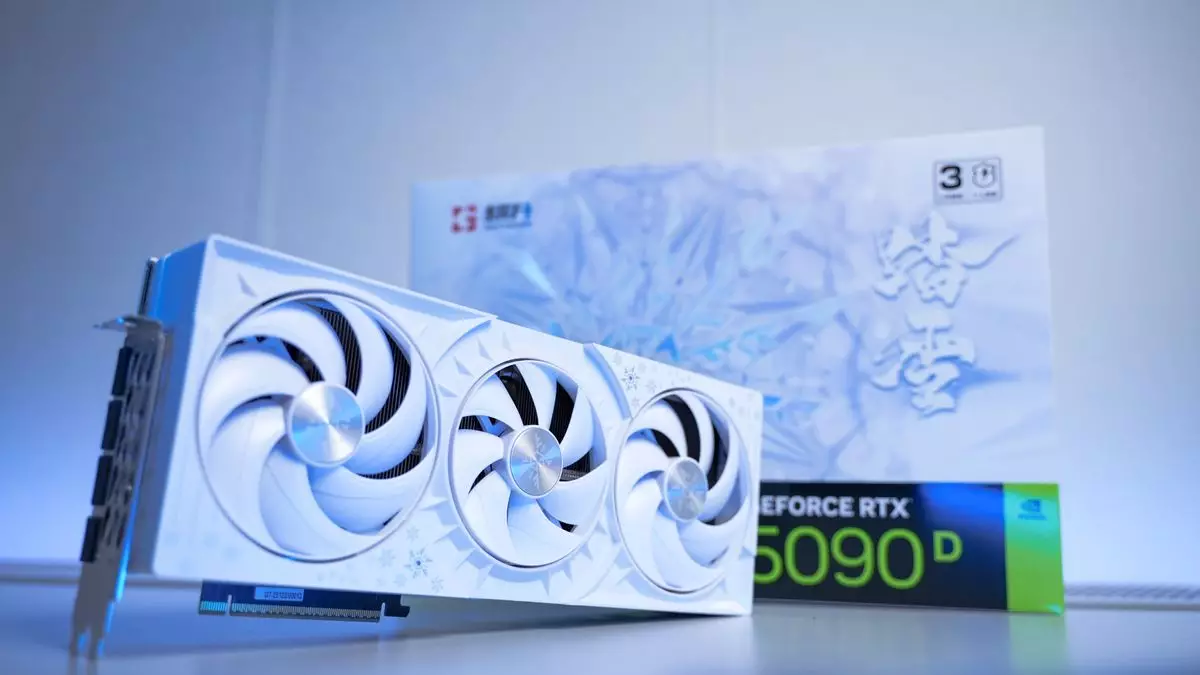The impending release of Nvidia’s RTX 50 series graphics cards has stirred considerable excitement among tech enthusiasts and gamers alike. Undoubtedly, one of the standout contenders is Gainward’s elegantly designed RTX 5090 D model. This iteration is not just a product but a symbol of cutting-edge design, sporting a striking all-white build adorned with snowflakes and sharp, thorn-like edges encircling its fan. This attention to aesthetic detail reflects an elevation in the perceived value of tech products, making a statement beyond mere functionality.
Unlike the conventionally sleek designs commonly associated with high-performance graphics cards, the Gainward RTX 5090 D dares to veil its technical prowess in an eye-catching frosty exterior. The graphics card boldly features the Gainward brand, prominently displayed on both the back and sides. While excessive branding can often detract from the overall allure of tech products, the uniqueness of this design seems to justify the logo’s visibility. It’s fascinating to witness how visual appeal can influence consumer desire, generating interest not only in capabilities but also in appearances.
The RTX 5090 D’s development comes in the wake of export restrictions placed by the United States, particularly concerning technologies pertaining to artificial intelligence and cryptocurrency. To circumvent these restrictions, Gainward introduced the “D” version of its cards as a means of compliance, following the initial appearance of the RTX 4090 D. However, this adaptation brings its own set of challenges; namely, reduced peak computational performance. Specifically designed to align with US regulations, the RTX 5090 D will not match the raw power of its unencumbered RTX 5090 counterpart. Instead, it features limited measurements regarding Total Processing Performance (TPP), which raises concerns about the efficacy of the D version in high-demand environments.
Further complicating the landscape is the geopolitical tension surrounding Nvidia’s operations in China. The Chinese government has embarked on an antitrust investigation regarding Nvidia’s acquisition of Mellanox Technologies, reflecting deeper regulatory dynamics at play. The intricacies of these relationships underscore the broader implications of technological advancement and market access. As such, the RTX 5090 D could emerge as a litmus test for how well Nvidia navigates these potential roadblocks. Despite these complications, there remains some optimism about the GPU’s performance. It boasts the same 32GB of GDDR7 RAM and 21,760 CUDA cores present in its more powerful counterpart, hinting that it still holds promise for competitive performance, albeit within a constrained framework.
One cannot ignore the tantalizing aspect of exclusivity associated with certain graphics cards and gaming devices, particularly within the Chinese market. The RTX 5090 D joins a cadre of aesthetically pleasing, yet regionally exclusive products that have captured attention, such as Razer’s collaborations with popular franchises like Pokémon and iconic anime series like Evangelion. The distinctiveness of these items does more than fulfill a functional purpose; they resonate with fans on a cultural level, cementing a deep emotional connection to the brands. Such exclusivity ignites a longing for items that may never reach certain markets, elevating their desirability—a phenomenon that Gainward cleverly capitalizes on with its stunning design.
The Gainward RTX 5090 D embodies a blend of sophistication and technology that appeals to aesthetics and functionality. While it may not reach the peak performance benchmarks set by the standard RTX 5090, its exquisite design has surely captured the hearts of many enthusiasts. As we await further details—specifically, retail pricing and launch dates—it’s clear that the RTX 5090 D, despite its limitations, has carved out a unique niche in the competitive landscape of graphics cards. The yearning for such a visually stunning piece of technology highlights the way in which design can elevate our perception of performance products, making them objects of desire in their own right.

